|
Turn to next page >>
|
|
(click picture for enlargement)
|
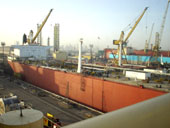 |
I joined "Eli Mærsk" in the docks in Dubai, United Arab Emirates. She was not dry docked, but was berthed for main engine repairs. That ment loads of people were running around on the ship, even some you didn't know. We had a total of 14 days in Dubai, and the crew and I enjoyed trips to the city, only a 5 minute cap drive away.
Here we're having a look at the ship on our left side, as seen from my cabin. |
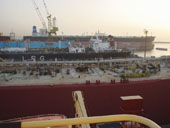 |
A look to the left of the ship. The three ships closest to me are all dry docked. The light blue one is "Ehm Mærsk", another ship from the same company. She was docked for rutine repairs after a few years of operation for BP marine. It was very exiting being this close to so many other ships. |
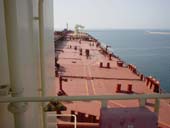 |
A view of the ship as seen from B-deck. The cranes (only one visible) are used for pulling pipelines on board, when preparing for loading/discharging. Since the decks of a tanker can be slippery when wet, special paint with sand in it is used for making "side walks", one seen here outlined with yellow paint. |
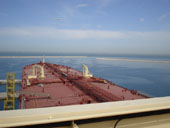 |
Still berthed in Dubai, there was a fantastic view from the ship. Here we view the entrance to the Dubai Dry Docks, loads of ships anchored in the horison. The yellow tower to the left in the picture was our gangway, supplied by the docks. It was a seven story climb from the pier to reach deck level! |
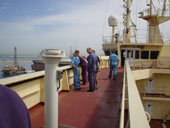 |
Some of the crew of the "Eli Mærsk" assembled in the port bridge wing, having a look at action in the dry dock beside us. The Chief Engineer is seen walking away, while Second Officer Meinhard, 1st Engineer Rene, 2nd Engineer Nils-Erik and the main engine repair supervisor are standing in a group. Note the gyro-compass repeater in the fore ground. It is frequently used for navigation while at sea. There's nothing like taking a walk in the bridge wing in a warm dark night, stars filling the sky above. |
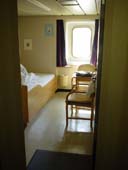 |
A look into my cabin on B-deck. Not as spacious as that on "Knud Mærsk", but still cozy. The officers' cabins are noticably larger, have a sofa and a larger table. The senior officers (Captain, Chief Officer, Chief Engineer and 1st Engineer) have even larger cabins, and sometimes have their own computer and tv set. |
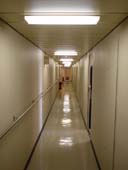 |
Taking a look down the corridor on B-deck, just outside the open cabin door to my cabin (foreground). Cabin doors are normally only locked in harbor, or when people, who are not part of the crew, are on board. |
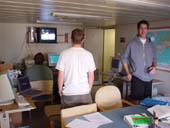 |
A relaxed atmosphere in the Conference Room after a day's work. The Conference Room served as class room for us (cadets) on sundays, and we also used it as a living room in the spare time. It is fitted with a computer network, a stereo, TV and video, and a PlayStation, all of which were often used in the evenings. |
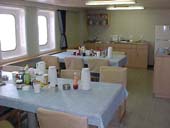 |
The Duty Mess, where the crew have their meals during working hours, or when, for some other reason, wearing working clothes. The dining saloon is used in the evening and for saturday dinners, which are usually a lot more delicate that on normal week days. |
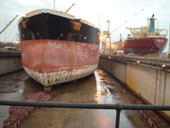 |
This large ship (actually smaller than "Eli Mærsk") was docked due to a collision with another ship about the same size. The collision had left a large hole in the side of the ship (visible on next picture). Notice the man in blue clothes standing at the right side of the dry dock, just visible above the railing. These docks are huge! |
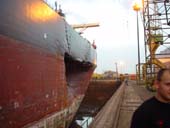 |
The massive hole in the side of the ship. It was due to be docked for 90 days for repairs, clearly a very extensive operation. |
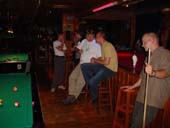 |
Spending two weeks in Dubai, we often went out to see the city and have some fun when work was over. In this bar we enjoyed a game of pool and talked to some of the locals. Jens, with the cue, is carefully pondering his next shot. |
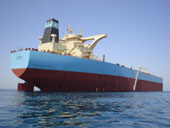 |
Having left Dubai, we're anchored off Fujairah (UAE) waiting for cargo. It coincided with the testing of the life boats, which provided an exellent chance to shoot a few pictures of the "Eli Mærsk". Here she is, 330 meters long, 59 meters wide and more than 20 meters from deck to water level (in ballast). |
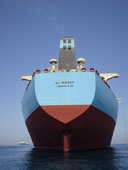 |
A great picture of the transom and stern of the ship. The huge rudder is actually the same size as a small house, giving the ship a magnificent momentum when turning. Eli Mærsk has one propeller (not visible here), and being 10 meters in diameter, it's a huge one! |
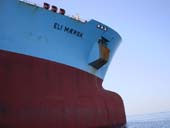 |
The starboard bow with the 17 ton anchor visible above the big block. The purpose of the block is to keep the anchor away from the hull. The draught-marks can be seen on the bulbous bow. Looking closely one will notice that some of the marks are bigger than the others. The distance between each of these big marks is 1 meter. |
 |
Still anchored off Fujairah, waiting by the lifeboats (upper side of picture) for instructions from the officers. Notice all the piping on the deck in the back ground. It takes quite a while figuring out what all the pipes are for! The persons in the picture are my fellow cadets, and in the middle of the picture in a purple boiler suit, hidden behind a pillar, is one of the Phillipine Ship's Assistants. |
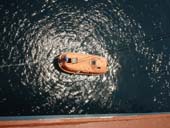 |
Looking down the side of the ship during rutine testing of the life boats. Here the boat has just reached the water, and 1st Engineer René is detaching the bow line. In case of a real emergency everybody enters the life boat, and then it is lowered from inside. Here during testing we entered the boat after lowering using the gangway midships. |
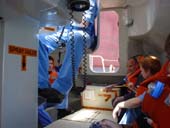 |
Inside the life boat people are packed closely together, while the helmsman's seat is placed higher to make lookout possible. The life boat is equipped with a 4 cyl 4-stroke engine, giving it a speed of approx. 7 knots. Furthermore it has a spray water system, which covers the whole exterior, enabling the boat to sail through fire! |
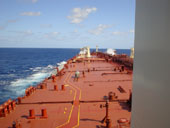 |
After loading in Ras Tanurah, Saudi Arabia, we steamed towards the Carribean Island Saint Eustatius for discharge. While still in the Persian Gulf I shot this picture of the water coming in over the bow. It is actually a frequent sight when the ship is loaded. |
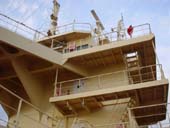 |
A view of the port side of the accomodation as seen from C-deck. The inside pressure is kept slightly above the ambient pressure, to prevent salty sea air from entering the living quarters. |
 |
Here we are having a look of the "back yard" as we called it, the space between the accomodation (right) and the engine room casing (left). The open door in the right foreground leeds to the ship's workshop, while the one in the casing leeds to the engine room. The big hatch in the middle allows for engine room access for cranes etc. |
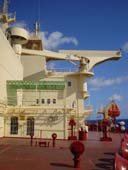 |
Here I'm standing on the poop deck looking forward. The green roof covers the swimming pool, which was very popular in the warm waters of the South Atlantic. The three red things in the foreground are pressure/vacuum valves. They prevent the difference between the pressure in a tank and ambient pressure from getting too great. The two taller pipes standing by the pool are overflow valves, and between these is a fuel oil tank hatch. |
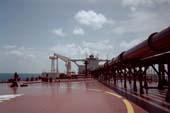 |
Looking aft. The red mast in the middle of the picture is the so called mast riser. Being nothing more than a big valve, it lets out gases from the tanks during loading. The large pipes to my right are the deck main cargo lines, which connect the cargo tanks with the cargo pumps and the manifold. They are 0.7 meters (2.3 feet) in diameter. |
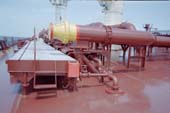 |
The manifold, through which the oil flows during loading and discharging. When discharging, each of the ship's three cargo pumps can pump 5,500 cubic meters of oil ashore per hour. The ship's pumps are only used for discharging, while the oil terminal's pumps are used when loading the ship. |
| Turn to next page >> |